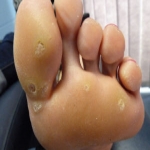Warts! That wasn’t there a week ago!

Progression of wart after freezing.
What is a wart? Essentially, warts are noncancerous growths on the surface of the skin. An old wives’ tale says that playing with frogs will cause a wart. Luckily, we can put that claim to rest since science has proven that theory false. In actuality, they are most often caused by the human papilloma virus (HPV) being introduced to your immune system through a cut or damage to the skin. Warts come in a variety of colors, symptoms, and locations on the body. Let’s look at some of the various kinds of warts, shall we?
Types of Warts
Common Warts (verruca vulgaris)- as the name suggest, these are the warts most commonly seen on the hands. These warts are easily spread from the hands to the face due to the skin of the hands being broken often due to nail biting or picking at hang nails. Some of these warts will have small black specks resembling seeds and are often rough to the touch. Sometimes, these warts are often mistaken for mucous cysts. These cysts are due to osteoarthritis and form on the back side of the finger at the joints.
Mucous Cyst
Foot warts (plantar warts)- named for their location on the plantar surface (soles) of the feet. Unlike common warts that appear raised, plantar warts are level and grow inward and deep into the feet. Most people feel the sensation of having something stuck in their shoe, causing pain with walking.
Flat warts can occur anywhere and tend to grow from anywhere from 20-100 warts at a time but are smaller than other types of warts. Children, teens, people who bite their nails, or people with a compromised immune system are prone to developing warts. Additionally, areas of skin that are shaved (especially faces or legs), are also prone to warts. They can spread from body part to body part, person to person, or person to object (sharing towels).

Can They Be Cured?
Unfortunately, there is no definitive cure for warts, but there are many ways to treat warts. Often, a wart will clear up on its own without treatment, which is a likely scenario for children. Adults with warts often have symptoms that warrant treatment to remove the wart. Simple treatments include excision, freezing, burning and scraping the wart, or using a method involving cantharidin, a formula that causes a blister under the wart that kills the wart on the surface. For more difficult warts, or warts caused by a weakened immune system, more drastic measures could be taken, including laser treatments, chemical peels, immunotherapy, or Bleomycin injections.
If you suspect a wart, a primary care physician, dermatologist, or even your orthopedic doctor are all useful resources to advise proper treatments.
Riki Duncan, MA. Ed, ATC, LAT
https://www.aad.org/public/diseases/contagious-skin-diseases/warts#treatment
http://www.assh.org/handcare/hand-arm-conditions/Warts

